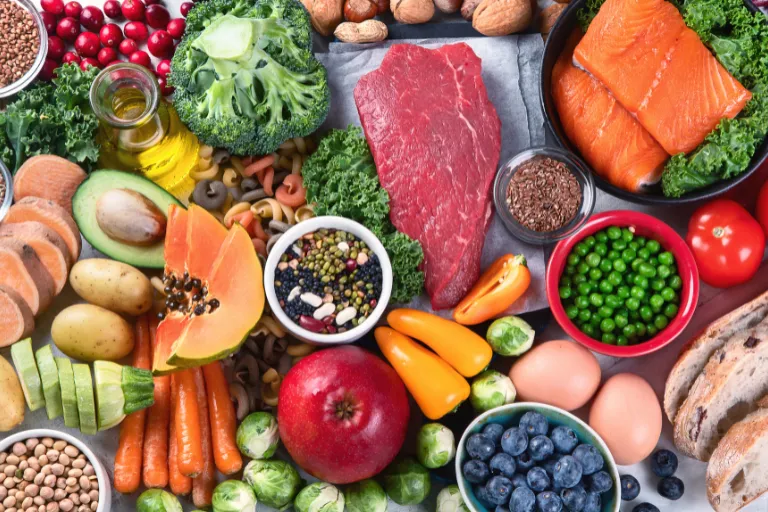Wichtige Punkte
- Due to its restrictive nature, AIP should be followed under the guidance of a trained health professional.
- The Autoimmune Protocol (AIP) is a food-first approach designed to reduce inflammation and support immune balance in individuals with autoimmune disorders.
- It consists of two main phases: an elimination phase and a structured reintroduction phase to identify food triggers.
- AIP focuses on nutrient-dense, anti-inflammatory foods while removing common irritants.
- Early studies show improvements in symptom severity, gut health, and quality of life.
When Food Becomes More Than Fuel
For millions of Americans living with autoimmune symptoms—ranging from joint pain and digestive discomfort to chronic tiredness and skin flares—the daily burden can be relentless. While medications help manage immune overactivity, many people are looking beyond prescriptions. Increasingly, they’re turning to food—not as a cure, but as a strategic tool. Among the most talked-about approaches: the Autoimmune Protocol Diet, or AIP.
But what is AIP exactly? And does it work?
Why It Matters: A Growing Autoimmune Burden
Autoimmune disorders occur when the immune system mistakenly attacks the body’s own tissues, leading to chronic inflammation and a cascade of symptoms. Over 24 million Americans are affected, according to the National Institutes of Health, with conditions like Hashimoto’s thyroiditis, inflammatory gut issues, and psoriasis becoming increasingly common.
While genetics play a role, environmental triggers—particularly diet, stress, and gut health—are now seen as major contributors. Research increasingly points to the gut microbiome and intestinal barrier as critical players in immune regulation (Belkaid & Hand, 2014; Fasano, 2012).
This is where the Autoimmune Protocol comes into play: a structured dietary reset that aims to identify and remove immune triggers through food.
The Problem: Elusive Triggers and Daily Frustrations
Autoimmune symptoms are notoriously unpredictable. One day, energy and digestion improve. The next, brain fog or bloating returns—often without a clear explanation.
Identifying what’s behind these flare-ups is part of the challenge. Food sensitivities, intestinal permeability (“leaky gut”), and stress-induced inflammation are among the potential culprits. The AIP diet provides a framework for systematically removing—and then carefully reintroducing—common immune triggers to help users uncover their personal sensitivities.
The Science Behind AIP: Gut, Immune System, and Inflammation
The AIP diet builds on the foundations of Paleo eating, but it eliminates even more foods suspected of irritating the immune system or gut lining—such as grains, dairy, legumes, refined sugar, eggs, and nightshades. It also removes additives, seed oils, and alcohol.
The rationale stems from research suggesting that increased intestinal permeability allows food antigens and microbial toxins to cross the gut barrier and activate the immune system. This mechanism has been associated with autoimmune symptoms (Fasano, 2012; DeMeo et al., 2002).
In a 2017 clinical study published in Inflammatory Bowel Diseases, researchers followed 15 adults with inflammatory gut issues who adopted the AIP diet for 11 weeks. Participants reported significant improvements in symptom severity and quality of life—with 73% achieving clinical remission by the study’s end, and no serious adverse events noted during the study period (Konijeti et al., 2017).
Another pilot study, published in Cureus in 2019, evaluated the impact of AIP in individuals with Hashimoto’s thyroiditis. Over 10 weeks, participants saw reductions in fatigue, joint pain, and inflammatory markers like hs-CRP, again with no serious adverse events reported (Abbott et al., 2019).
How the AIP Diet Works: Phases and Foods
Phase 1: Elimination
This phase typically lasts 30 to 90 days and involves strict avoidance of potentially inflammatory foods. In their place, users eat nutrient-dense, anti-inflammatory options like:
- Grass-fed meats and wild-caught fish
- Organ meats (rich in iron and B vitamins)
- Leafy greens and sulfur-rich vegetables
- Bone broth, fermented vegetables, coconut, and olive oil
Phase 2: Reintroduction
Once symptoms stabilize, foods are reintroduced one at a time over several days while monitoring for symptom return. The goal is to identify personal triggers—what one person tolerates may inflame another.
Experts caution against staying in the elimination phase too long. Without careful planning, users may develop deficiencies in calcium, vitamin D, or carbohydrates. As a result, health professionals recommend implementing AIP under supervision from a registered dietitian or trained coach (Ballantyne, 2023).
Abonnieren Sie kostenlos weitere Gesundheitstipps und Expertenrat direkt in Ihrem Posteingang.
Benefits and Challenges of the AIP Diet
Potential Benefits
- Calmer digestion and reduced bloating
- Fewer skin and joint flares
- More stable mood and energy
- Empowerment through food awareness
Common Challenges
- High restrictiveness may lead to burnout
- Difficult to maintain in social settings or while traveling
- Risk of nutrient gaps if not carefully managed
“AIP isn’t forever,” says Angie Alt, a nutritionist and co-author of The Autoimmune Wellness Handbook. “It’s a tool to help users reset and learn about their body—not a permanent lifestyle.”
What Experts and Users Say
Functional medicine practitioners and integrative nutritionists increasingly use AIP as a therapeutic tool. Dr. Sarah Ballantyne, PhD, a biomedical researcher and one of AIP’s earliest advocates, highlights changes in the gut microbiome as one of the diet’s strengths. In her review of current research, she notes that AIP increases microbial diversity and reduces inflammatory markers in a matter of weeks (Ballantyne, 2023).
Skeptics argue that larger, controlled studies are still needed. “The data are promising, but early,” says Dr. Amy Burkhart, MD, RD. “We need more rigorous trials. That said, many individuals do feel better on AIP, especially when guided properly.”
Online testimonials echo this cautious optimism. In forums like Reddit’s r/AutoImmuneProtocol and AIP-specific Facebook groups, users share recipes, tips, and stories of symptom relief—but also frustrations with social restrictions, cost, and food monotony.
Final Word: Food as a Tool, Not a Cure
The Autoimmune Protocol isn’t a miracle solution—but it can be a powerful tool for reducing inflammation and uncovering hidden food sensitivities. When used under expert guidance, AIP offers a way to calm symptoms and reclaim a sense of control.
If you’re considering AIP, prioritize nutrient diversity, monitor symptoms thoughtfully, and partner with a health professional to avoid common pitfalls.
Nächste Schritte
- Explore AIP meal planning and tips at Autoimmune Wellness
- Review clinical studies via PubMed
- Find a trained expert at AIP Certified Coaches
Quellen
- Abbott RD, Sapsin H, Huebner JL, et al. “Effects of the Autoimmune Protocol Diet on Hashimoto’s Thyroiditis: A Pilot Study.” Cureus. 2019. https://doi.org/10.7759/cureus.4122
- Ballantyne S. “How the Autoimmune Protocol Works.” The Paleo Mom. Updated 2023. https://www.thepaleomom.com/autoimmune-protocol/
- Belkaid Y, Hand TW. “Role of the Microbiota in Immunity and Inflammation.” Cell. 2014. https://doi.org/10.1016/j.cell.2014.03.011
- DeMeo MT, et al. “Intestinal Permeability Defects in IBS.” Am J Gastroenterol. 2002. https://doi.org/10.1111/j.1572-0241.2002.06052.x
- Fasano A. “Leaky Gut and Autoimmune Diseases.” Clin Rev Allergy Immunol. 2012. https://doi.org/10.1007/s12016-011-8291-x
- Konijeti GG, et al. “Efficacy of the Autoimmune Protocol Diet for Inflammatory Bowel Disease.” Inflamm Bowel Dis. 2017. https://doi.org/10.1097/MIB.0000000000001221
Der Artikel stellt in keiner Weise eine medizinische Beratung dar. Bitte konsultieren Sie einen zugelassenen Arzt, bevor Sie eine Behandlung beginnen. Diese Website kann Provisionen für die in diesem Artikel erwähnten Links oder Produkte erhalten.
Abonnieren Sie kostenlos weitere Gesundheitstipps und Expertenrat direkt in Ihrem Posteingang.
Last Updated on Juli 25, 2025



